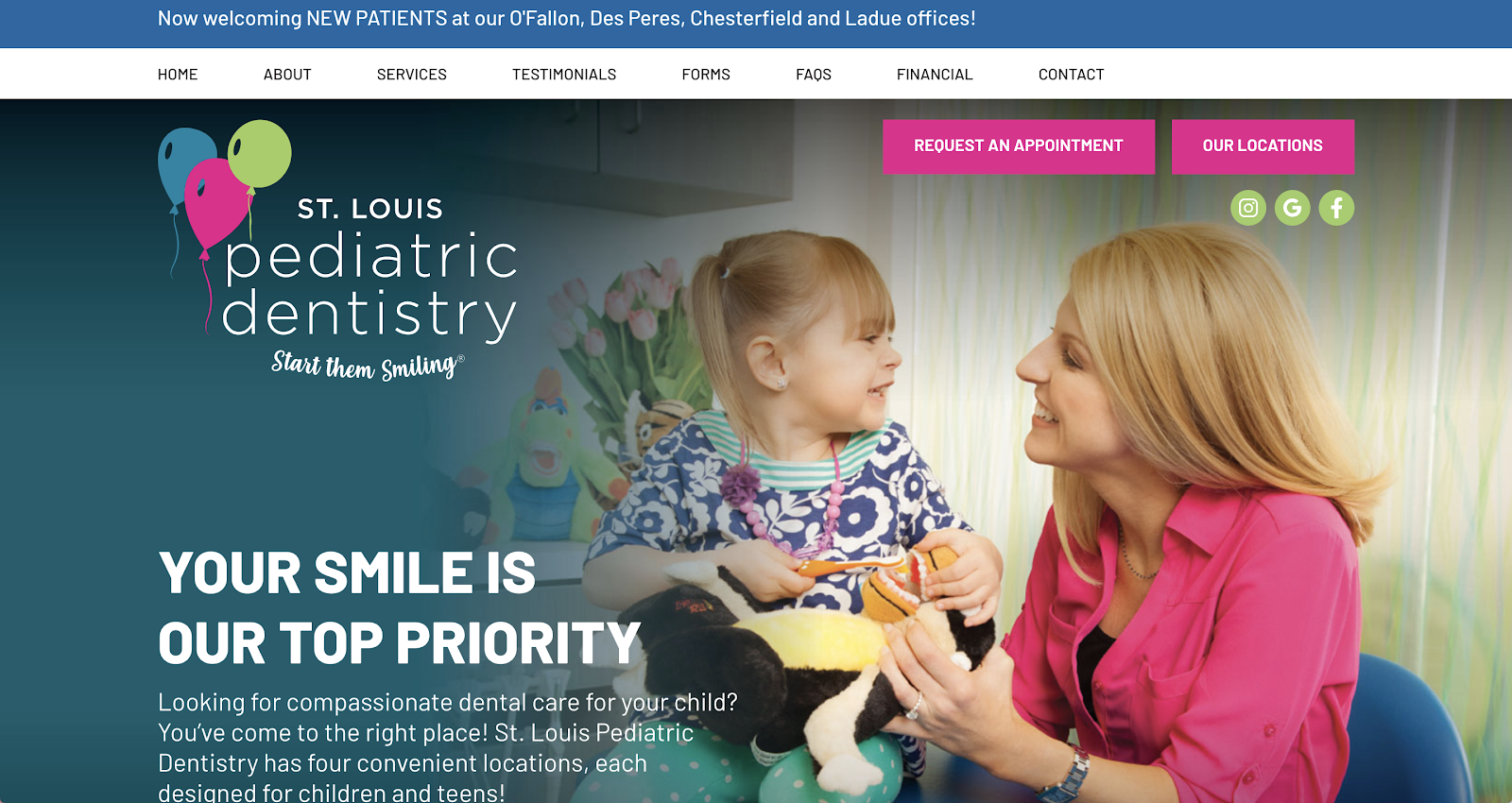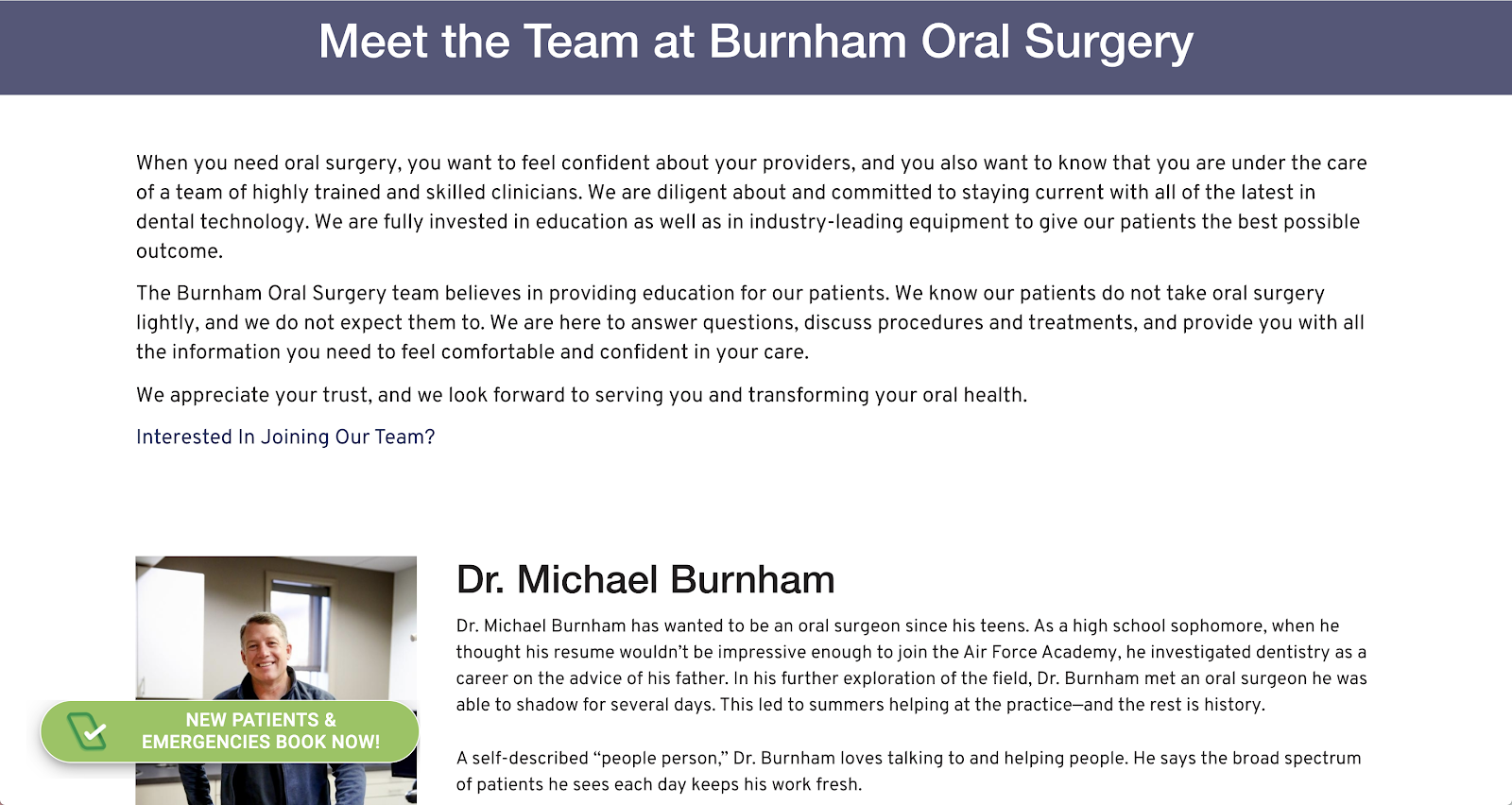Share this
9 Elements to Include in Your Dental Website
by Great Dental Websites on Mar 14, 2021 10:00:00 PM
Your dental website is like a salesperson. It works tirelessly for you, 24 hours a day, and every day of the year.
The goal of any salesperson is to speak directly to a prospective patient, and convince them that your dental office is the right choice.
And that's exactly what your website should do. An effective dental website will turn first-time website visitors into first-time patients.
But how?
In this post, we’ll share the exact elements you need to include on your website to turn it into the best salesperson ever.
1. Home Page

View more of this website here
Let’s start with your home page.
This is also where many of your website visitors will start.
Your home page is one of the most powerful pages on your website, for several reasons:
- First, your home page gives visitors a glimpse into who you are as a dental practice (including your values and your personality).
- Second, your home page quickly tells prospective patients why they should choose your practice.
- Third, your home page gives visitors easy access to other important pages on your website.
Your site visitors will form an impression of your practice after just a few seconds of being on your home page.
If they develop a negative first impression, they’ll likely hit the back button, forget about you, and move on to your competitor.
But if you’re able to connect with them through your home page, your visitor may book an appointment, become a loyal patient, refer others to you, and live happily ever after. This is why you must create a quality home page.
Here's what to include on your home page to make it an effective salesperson:
Your business address and phone number
Your dental practice website should include your business address and phone number. As a general rule, this information should be prominently displayed in the upper right hand corner of your home page (and every other major page on your website). Why that exact placement? Research shows that most visitors tend to look for contact information in that area.
Including your business address and phone number on every page of your website is also important for local SEO (search engine optimization). If you want people to see your website when they search for “dentists in [your city name],” share your business’ address and phone number all over your website. It lets Google, Bing, and other search engines know that your dental practice is local.
Including your practice’s contact information makes it convenient for your prospective and current patients to contact you. Instead of searching through multiple pages for your practice’s phone number, they’ll be able to see it from everywhere—almost like a bat signal.
Plus, on mobile devices, visitors can simply click on your phone number to call.
A main call to action
Although your home page will provide links to other pages on your site, there should be one main action that you ask your visitor to do. This is known as a call to action.
For most dental practices, the best call to action is “schedule an appointment.” This simple invitation lets your website visitors know that you are presently accepting new patients and interested in serving them.
After landing on your home page, what action would you like your visitor to take?
- Make an appointment (perfect for most dental practices)
- Learn about the services you provide (good for educating prospective patients)
- Read testimonials about your services (provides social proof and builds trust)
- Check out your blog (another place to educate and build trust)
- Sign up for your email newsletter (great for building your email subscriber list)
As you can see, there are many calls to action that you can include on your home page. Choose the one that meets your present objectives.
Social media buttons
Are you active on social media? Link to your social media pages on your home and contact pages. You can also add social media links in the header or footer of every page on your website (near your address and phone number).
Some visitors may wish to follow you on social media, especially if you have an established community. This way, they can stay connected to you and be updated if you run any specials in the future.
Trust signals
Have you won any awards? Do you have one or two testimonials that truly reflect who you are as a dental practice?
These trust signals inspire prospective patients to take a risk on you. After all, it’s not much of a risk if others have used your services before and were satisfied. Social proof is an important element to add to your home page because we, humans, are influenced by the positive outcomes of others.
A statement of who you are
While you’ll have an “About Us” page to go into detail, be sure to provide a quick snapshot of who you are as a dental practice.
- What do you value?
- Who do you serve?
- Why should someone choose you?
You can use a combination of words and visuals to convey your message. Create a tagline that captures who you are in 10 words of less, such as:
- “Exceptional dentistry with a personal touch”
- “From baby teeth to braces”
- “Your local, comprehensive dental solution for the entire family”
(All of these are live examples. See more examples here.)
Easy navigation
What are the top pages that you want current and prospective patients to visit? Feature them at the top of your home page as part of your site’s navigation menu.
Make it easy for your visitors to go where they want. This creates a simple but satisfying user experience on your website.
The ability to make an appointment quickly
Ideally, your visitor should be able to make an appointment from any page on your website. This includes your home page. Remove any obstacles and be sure that visitors know exactly how to request an appointment.
In our research, the top-performing websites make it dead simple to book an appointment. Don’t nestle it away on your Contact Us page.
2. Services Page
The services page is another important element on your dental website. It’s often one of the most visited pages and that’s because your visitors want to know what you do and how you can help them.
Use your services page to educate your current and prospective patients. Discuss what services you offer in easy to understand terms. Remember that your intended audience isn’t made up of fellow dentists. They may be in pain and looking for a ray of hope. Your educational services page can help them understand what you provide.
If you offer a long list of services, consider breaking them into multiple pages, one for each unique service. This makes it easier for patients who want to learn more about a specific service. Instead of reading through non-relevant information, they can just click through to the information that they care about.
3. Testimonials
Your testimonials page provides a list of reviews about your service. People tend to trust reviews more than a website’s own marketing copy.
It’s a good idea to dedicate one page on your website for testimonials. But prioritize these testimonials and lead with the most impactful. Most visitors won’t read past the second review.
4. Smile Galleries
In addition to testimonials, share a gallery of your work. Do before and afters of each procedure that you offer, if possible. This allows prospective patients a chance to see the dental transformation.
5. FAQs Page
What questions do you answer over and over again?
No doubt, you have a long list of questions that your current and prospective patients ask you. Compile the top 10-20 questions into a list and share them on a frequently asked questions (FAQ) page. Be sure to link to this page on your “Contact Us” page, too.
6. Blog
You may not have a blog, and that’s okay. However, blogging makes it easier to show up on Google for local queries (like “[your city] dentists”).
Blogging also keeps you in contact with your patients. You can use your blog to provide valuable information about the latest procedures or any specials that your office is running.
7. Contact Us Page

View more of this website here
Although you should include your phone number and address on every page of your website, you’ll still need a “Contact Us” page.
On your “Contact Us” page, include your address, phone number, and an email form so that your visitor can reach out to schedule an appointment or ask a question. Also include your hours of operation.
Some dental practices also include a map and a set of directions.
8. Meet the Team Page
You may not know this, but your “About Us” page is crucial for developing a rapport with your prospective patient. They want to know who they’ll meet when they arrive for an appointment. That includes the receptionists, the hygienists, the nurses, the technicians, and of course, the dentists—everyone should be represented.
Add short-and-sweet bios for all of your team members. Include photos, too. It forges an immediate connection with your prospective patients.
9. New Patient Information
On this page, share all of the information that a new patient needs to know or do, such as what to expect on their first visit. Your patient information page may include intake forms so that it’s easier for your patients when they first arrive. It can also provide financial information. You may consider linking to your FAQs on this page as well.
Final Thoughts
Your website will sell your services night and day. It needs to accurately represent who you are as a practice and what value you offer patients.
Talk with us about building your own persuasive dental website. Click here to schedule a completely free dental website consultation.
Share this
- February 2024 (1)
- January 2024 (2)
- December 2023 (1)
- November 2023 (1)
- October 2023 (1)
- September 2023 (2)
- August 2023 (4)
- July 2023 (3)
- June 2023 (2)
- May 2023 (1)
- April 2023 (3)
- March 2023 (2)
- February 2023 (2)
- January 2023 (3)
- December 2022 (2)
- October 2022 (3)
- September 2022 (2)
- August 2022 (2)
- July 2022 (1)
- June 2022 (1)
- May 2022 (1)
- April 2022 (5)
- March 2022 (4)
- February 2022 (20)
- January 2022 (14)
- December 2021 (1)
- November 2021 (4)
- October 2021 (1)
- September 2021 (2)
- August 2021 (12)
- July 2021 (40)
- June 2021 (2)
- May 2021 (5)
- April 2021 (7)
- March 2021 (4)
- February 2021 (13)
- January 2021 (5)
- December 2020 (3)
- November 2020 (24)
- October 2020 (37)

